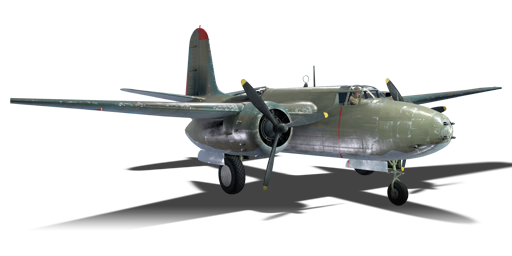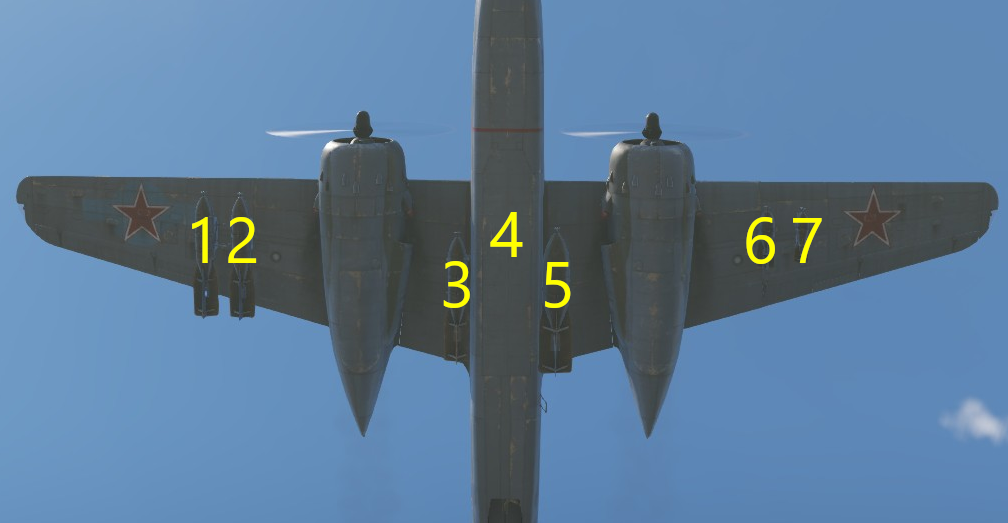Difference between revisions of "A-20G-30 (USSR)"
Colok76286 (talk | contribs) (Edits) |
Colok76286 (talk | contribs) (Added About template) |
||
| Line 1: | Line 1: | ||
| + | {{About | ||
| + | | about = premium bomber '''{{PAGENAME}}''' | ||
| + | | usage = other versions | ||
| + | | link = DB-7 (Family) | ||
| + | }} | ||
{{Specs-Card | {{Specs-Card | ||
|code=a_20g_30_ussr | |code=a_20g_30_ussr | ||
Revision as of 18:40, 16 November 2022
| This page is about the premium bomber A-20G-30 (USSR). For other versions, see DB-7 (Family). |
Contents
Description
The ▂A-20G-30 Havoc is a premium rank III Soviet bomber with a battle rating of 3.7 (AB/RB/SB). It was introduced in Update "Fire and Ice".
General info
Flight performance
Describe how the aircraft behaves in the air. Speed, manoeuvrability, acceleration and allowable loads - these are the most important characteristics of the vehicle.
| Characteristics | Max speed (km/h at _,___ m) |
Max altitude (metres) |
Turn time (seconds) |
Rate of climb (metres/second) |
Take-off run (metres) | |||
|---|---|---|---|---|---|---|---|---|
| AB | RB | AB | RB | AB | RB | |||
| Stock | ___ | ___ | 7224 | __._ | __._ | __._ | __._ | ___ |
| Upgraded | ___ | ___ | __._ | __._ | __._ | __._ | ||
Details
| Features | ||||
|---|---|---|---|---|
| Combat flaps | Take-off flaps | Landing flaps | Air brakes | Arrestor gear |
| _ | _ | _ | _ | _ |
| Limits | ||||||
|---|---|---|---|---|---|---|
| Wings (km/h) | Gear (km/h) | Flaps (km/h) | Max Static G | |||
| Combat | Take-off | Landing | + | - | ||
| 0 | 296 | ___ | ___ | ___ | ~__ | ~__ |
| Optimal velocities (km/h) | |||
|---|---|---|---|
| Ailerons | Rudder | Elevators | Radiator |
| < ___ | < ___ | < ___ | > ___ |
Survivability and armour
The A-20G-30 is rather well-protected. It sports 3 defensive .50 calibre guns, two in a dorsal turret capable of complete rotation, the other in a limited arc under the aircraft's tail. As for the armour, the pilot is protected by 57 mm bulletproof glass and several 12.7 mm steel plates in front of and behind, and 8 mm plates to his sides. The only thing to look out for is the chance of the tail section ripping off at a higher rate than its other bomber and ground attacking comrades.
Modifications and economy
Armaments
Offensive armament
The A-20G-30 (USSR) is armed with:
- 6 x 12.7 mm M2 Browning machine guns, nose-mounted (350 rpg = 2,100 total)
Suspended armament
The A-20G-30 (USSR) can be outfitted with the following ordnance presets:
- Without load
- 8 x 50 kg FAB-50sv bombs (400 kg total)
- 16 x 50 kg FAB-50sv bombs (800 kg total)
- 8 x 100 kg FAB-100sv bombs (800 kg total)
- 16 x 100 kg FAB-100sv bombs (1,600 kg total)
- 4 x 500 lb AN-M64A1 bombs (2,000 lb total)
- 6 x 250 kg FAB-250sv bombs (1,500 kg total)
- 2 x 500 kg FAB-500sv bombs (1,000 kg total)
- 2 x 1,000 kg FAB-1000 bombs (2,000 kg total)
- 2 x 450 mm 45-36NU torpedoes
Custom loadout options
| 1 | 2 | 3 | 4 | 5 | 6 | 7 | ||
|---|---|---|---|---|---|---|---|---|
| 50 kg FAB-50sv bombs | 1* | 1* | 4, 16 | 1* | 1* | |||
| 100 kg FAB-100sv bombs | 1* | 1* | 4, 16 | 1* | 1* | |||
| 250 kg FAB-250sv bombs | 1* | 1* | 1 | 1 | 1* | 1* | ||
| 500 kg FAB-500sv bombs | 1 | 1 | ||||||
| 1,000 kg FAB-1000 bombs | 1 | 1 | ||||||
| 500 lb AN-M64A1 bombs | 4 | |||||||
| 450 mm 45-36NU torpedoes | 1 | 1 | ||||||
| Maximum permissible loadout weight: 2,160 kg Maximum permissible wing load: 1,080 kg Maximum permissible weight imbalance: 1,080 kg | ||||||||
| * 50/100 kg bombs and 250 kg bombs cannot be mixed within each wing (hardpoints 1/2 and hardpoints 6/7) | ||||||||
Defensive armament
The A-20G-30 (USSR) is defended by:
- 2 x 12.7 mm M2 Browning machine guns, dorsal turret (400 rpg = 800 total)
- 1 x 12.7 mm M2 Browning machine gun, ventral turret (400 rpg)
The tail section of the plane creates a big blind spot for the dorsal turret. Be careful when enemies approach from behind because you will not be able to hit targets directly behind you.
Usage in battles
The A-20G-30 was a modification of the American A-20G-25, thus it excels at attacking soft targets such as howitzers and SPAA. The 6 x .50 calibre guns situated in the nose are fully capable of destroying light pillboxes en masse. While still capable of hitting bases with its 2 x 1,000 kg bombs, this aircraft is more effective with loads that contain larger numbers of bombs for soft targets.
With the 6 forward-facing .50 calibre guns and a decent turn time and rate of climb for a twin-engine aircraft, the A-20G-30 is well suited for the role of heavy fighter. Be warned, the A-20G-30 does not have the energy retention of dedicated heavy fighters like the Bf 110's in the German tech tree. This could lead to the aircraft being destroyed in such a dogfight.
Pros and cons
Pros:
- Great bomb load for an aircraft of this type
- Effective offensive armament
- High survivability
Cons:
- Lacklustre turn time
- Weak tail section
- Poor energy retention
History
Describe the history of the creation and combat usage of the aircraft in more detail than in the introduction. If the historical reference turns out to be too long, take it to a separate article, taking a link to the article about the vehicle and adding a block "/History" (example: https://wiki.warthunder.com/(Vehicle-name)/History) and add a link to it here using the main template. Be sure to reference text and sources by using <ref></ref>, as well as adding them at the end of the article with <references />. This section may also include the vehicle's dev blog entry (if applicable) and the in-game encyclopedia description (under === In-game description ===, also if applicable).
Media
Excellent additions to the article would be video guides, screenshots from the game, and photos.
See also
Links to the articles on the War Thunder Wiki that you think will be useful for the reader, for example:
- reference to the series of the aircraft;
- links to approximate analogues of other nations and research trees.
External links
Paste links to sources and external resources, such as:
- topic on the official game forum;
- other literature.
| Douglas Aircraft Company | |
|---|---|
| Strike Aircraft | A-20G-25 · A-26B-10 · A-26B-50 · AD-2 · AD-4 · A-1H |
| Bombers | TBD-1 · B-18A · SBD-3 · BTD-1 · A-26C-45 · A-26C-45DT |
| Turboprops | A2D-1 |
| Jet Aircraft | F3D-1 · F4D-1 |
| A-4 Skyhawk | A-4B · A-4E Early |
| Export | ▄Havoc Mk I · ▄Boston Mk I · ▄DB-7 · ▂A-20G-30 · ▄AD-4 · ▄AD-4NA |
| A-4 Skyhawk | A-4H · A-4E Early (M) · Ayit · A-4E |
| The Douglas Aircraft Company merged with McDonnell Aircraft Corporation in 1967 to form McDonnell Douglas. | |
| USSR bombers | |
|---|---|
| SB and Ar | SB 2M-100 · SB 2M-103 · SB 2M-103 MV-3 · SB 2M-103U · SB 2M-103U MV-3 · SB 2M-105 · Ar-2 |
| Yer-2 (petrol) | Yer-2 (M-105) · Yer-2 (M-105) TAT · Yer-2 (M-105R) TAT · Yer-2 (M-105R) LU |
| Yer-2 (diesel) | Yer-2 (ACh-30B) (e) · Yer-2 (ACh-30B) (l) |
| Tu | Tu-2 · Tu-2S · Tu-2S-44 · Tu-2S-59 · Tu-4 |
| Pe | Pe-2-1 · Pe-2-31 · Pe-2-83 · Pe-2-110 · Pe-2-205 · Pe-2-359 · Pe-8 |
| IL | DB-3B · IL-4 |
| Po | Po-2 · Po-2M |
| Other | MBR-2-M-34 · TB-3M-17-32 · Yak-4 · Be-6 |
| Lend-Lease | ▂PBY-5A Catalina · ▂Hampden TB Mk I · ▂A-20G-30 · ▂B-25J-30 |
| USSR premium aircraft | |
|---|---|
| Fighters | Krasnolutsky's I-15bis · I-16 type 28 · Zhukovsky's I-153-M62 · I-153P · I-180S · I-301 · ITP (M-1) |
| LaGG-3-4 · LaGG-3-23 · LaGG-3-34 · Dolgushin's La-7 · La-11 | |
| Eremin's Yak-3(e) · Yak-3 (VK-107) · Yak-3T · Golovachev's Yak-9M | |
| ▂P-39K-1 · ▂Pokryshkin's P-39N-0 · ▂P-39Q-15 · ▂P-40E-1 · ▂P-47D-27 · ▂P-63A-5 · ▂P-63A-10 · ▂P-63C-5 | |
| ▂Hurricane Mk IIB · ▂Spitfire Mk IXc · ▂Fw 190 D-9 | |
| Twin-engine fighters | I-29 |
| Jet fighters | Su-11 · MiG-15bis ISh · MiG-17AS · MiG-21S (R-13-300) · MiG-23ML |
| Strike aircraft | IL-2M "Avenger" · IL-2 M-82 · IL-8 (1944) · Su-6 · Tandem MAI · TIS MA · Su-8 · Tu-1 |
| Yak-38 · Su-7BMK · Su-25K · Su-39 | |
| Bombers | Po-2M · Be-6 · MBR-2-M-34 · Pe-2-205 · TB-3M-17-32 |
| ▂PBY-5A Catalina · ▂Hampden TB Mk I · ▂A-20G-30 · ▂B-25J-30 | |






